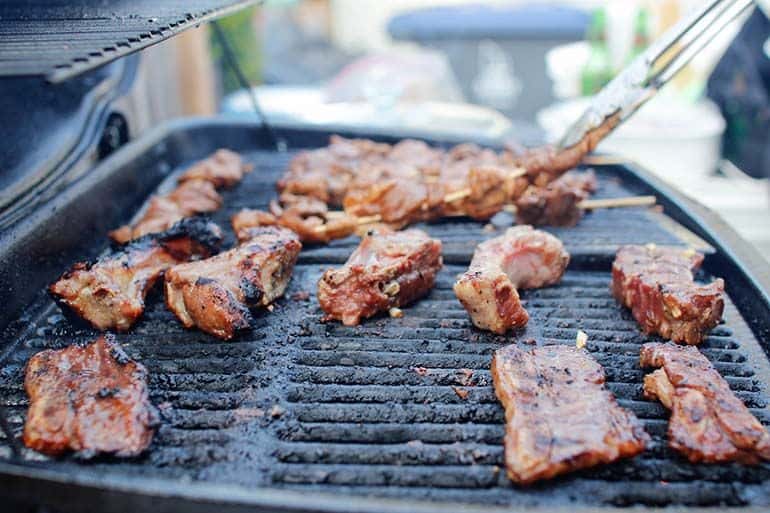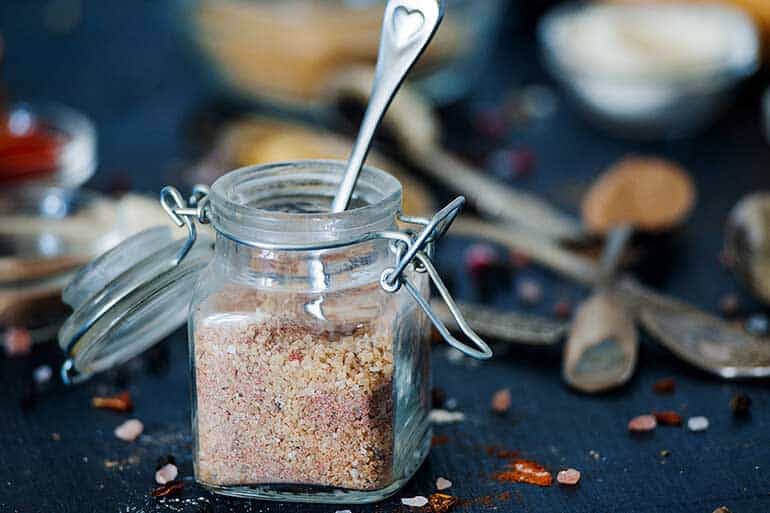Not sure where to start with your next rack of smoked BBQ ribs? From baby back to spareribs, here’s everything you need to know about the different types of pork ribs.

If you’ve been dying to try a new pork rib recipe, only to be stumped once you reach the butcher counter and been asked what type of pork ribs you want, you are not alone.
There are a number of different types out there, and each one is best suited to different recipes and meat prep approaches.
If you don’t know the difference between baby back or St Louis, this is the article for you. In this guide, we’ll show you the different types of rib and when you should pick each one.
Pork ribs explained
The pig ribcage has 14 rib bones (source), which can be split into the four main pork rib cuts:
- Baby back ribs
- Spareribs
- St Louis
- Rib tips
Each of these come from different parts of the ribcage.
At the top of the rib cage towards the rear of the animal is baby backs, which sit close to the backbone and underneath the loin muscle. As you move further away from the spine, the rib bones get larger, flatter and straighter, and also contain more meat between each rib. There is also more fat marbling as you get further from the spin and closer to the belly.
The frontmost ribs are connected to the breast bone, and this connection features a number of small bones and cartilage. This is what comprises rib tips.
Cuts also depend on how they’ve been cut as well as where they’ve been taken from in the pig.
Baby back ribs
Baby Backs come from the highest part of the ribcage, and closest to the spine of the pig. Because they are furthest away from the belly and therefore contain the least amount of fat and marbling, these are the leanest and most tender types of pork ribs.
Despite what the name might suggest, they don’t come from the rear of the pig. They are simply named ‘baby back’ because they’re smaller than the other most popular type of pork ribs, spare ribs.
Each slab of baby backs typically contains about 10-13 bones, making near full use of the full ribcage. They are usually trimmed at one end, with the shortest bone about 3 inches in length.
Their close position to the spine means that babybacks tend to be curved, almost like a hockey stick in shape. They often have about half an inch of pork loin meat on top.
Because they are leaner and lighter than spareribs, baby back ribs only need about 4 hours to smoke.
To prepare baby backs, remove the membrane (also called silver skin) from the rack using a blunt knife, and paper towel for purchase. Trim off any other excess fat or loose hanging meat. Season on both sides with a good pork rub.
Best Recipe: Texas Style Baby Back Ribs
Spareribs
Spare ribs are possibly the most popular cut of pork ribs, and are often the default choice for a lot of recipes and cookouts. So, if you hear someone refer to simple BBQ ribs, then chances are that they’re referring to spareribs.
Despite what the name might suggest, there’s nothing ‘spare’ or leftover about spareribs. They’re beautiful cuts of pork that are rich in meat and fat content, making them perfect for barbecue smoking. They are rich in flavor, making them often more popular than baby back ribs.
Spareribs come from further down the ribcage, at the end of baby backs, closer to the belly. They’re straighter and flatter than baby backs due to their proximity to the ends of the ribs. You’ll often see marrow at one of the ribs, where they’re cut from the baby back. The other end will have no bone sticking out, and will instead be where the bone tapers for the chest area of the pig.
Each slab should contain 11 bones, with more meat sitting between the bones than on them. There should be more marbling in the meat, and the combination of this with fat and connective tissue means that there should be more flavor in spares.
Where a rack of baby backs can usually be had by one person, a slab of spares should feed two people.
The meat preparation for spares is the same as baby back, so will also require the removal of the membrane. Trimming a rack of spare ribs is also straightforward. The difference will be in cook time. The high fat and meat content means that spares need longer on the smoker.
Best Recipe: Smoked Korean Spare Ribs
St Louis cut ribs
St Louis cuts are almost the same as spares, but with the gristly rib tips removed. The rectangular slab that remains is what we call St Louis ribs.
Because the cut is tidier and without the rough ends, St Louis ribs are often popular on the competition circuit for the sake of neat presentation. Just like with spares, a St Louis cut can serve two people.
St Louis ribs have an incredible pork flavor, partly thanks to their rich fat content, which makes it a firm favorite on the barbecue competition circuit when compared to baby back ribs.
This cut is often readily available at supermarkets or butchers, so to get your own simply buy a cut of spareribs and ask for the ends removed, or do it yourself.
Preparing your own St Louis ribs is easy, and can be done in just two steps (source). First, remove the ‘flap’ at the end of the rack. This is the pointy end of the rack, usually with a bit of loose meat attached to it. Cut vertically in line with the rack, about half an inch away from the short last bone.
Next, find the longest rib on the rack and aim to find a soft spot at the end of the rib. This is where the ribs connect to the breastbone of the pig. Insert your knife into this soft spot and slice horizontally, perpendicular to the ribs, removing the breastbone.
This should leave you with a rectangular rack, cleanly cut around the ribs and the meat in between.
After this, simply cut off any excess fat or meat hanging off the bones. Also check if the skirt needs removing. This is usually already removed by the butcher, but will need removing if not. The skirt is a little flap of meat that sits diagonally on the back side of the ribs.
Once ready you now have a St Louis cut that’s ready to be cut just like any cut of spareribs.
Rib tips
Remember the small strips of bone we threw away for St Louis ribs? These make our rib tips.
These are strips of bone that have been cut from the lower end of the spareribs, and are largely composed of small bone and cartilage. This can make eating them a bit more challenging, as they’re more chewy and the cartilage can make them tough.
They’re quite often discarded by cooks and butchers alike, but are still popular with some BBQ fans.
Although the rib tip cut is usually about 10 inches long and an inch or two wide, they’re cut in 2-inch cubes for serving.
A lot of people confuse rib tips and riblets, but they’re in fact not the same.
What are country style ribs?
Also simply called ‘country ribs’, these are in fact not really ribs. They come from the front end of the baby back near the shoulder. They mostly comprise of pork shoulder, and while they might have one or two ribs in, they’re not a rib rack. In the simplest terms, they’re essentially just pork chops.
Other styles of pork ribs
Riblets
Riblets are made from discarded parts of the full slab of ribs, or from trimming the rack down to just 2-3 inches in length. They’re often served as an appetizer, and should not be confused with rib tips.
Kansas City Style
No real difference in cut to St Louis ribs, however Kansas City style are characterized by uses of thick, sweet sauces brushed on top for a unique finish (source).
Loin ribs
The same as baby back ribs. Sometimes called loin ribs due to the cut’s close proximity to the pork loin.
Button ribs
Not really ribs. These are a thin and flat strip of meat that come from the pig’s spine area and rearmost rib. Button ribs don’t contain any actual rib, but instead little nubs from the backbone. This is what the ‘button’ actually refers to.
Side ribs
The same as spareribs. Referred to as ‘side’ ribs because they come from lower down the ribcage, or the ‘side’ of the pig.









